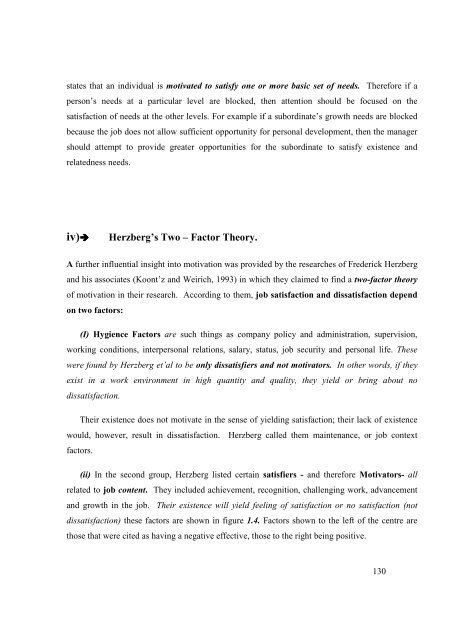HCM 433 MANGEMENT AND ORGANIZATIONAL BEHAVIOUR.pdf
HCM 433 MANGEMENT AND ORGANIZATIONAL BEHAVIOUR.pdf
HCM 433 MANGEMENT AND ORGANIZATIONAL BEHAVIOUR.pdf
Create successful ePaper yourself
Turn your PDF publications into a flip-book with our unique Google optimized e-Paper software.
states that an individual is motivated to satisfy one or more basic set of needs. Therefore if a<br />
person’s needs at a particular level are blocked, then attention should be focused on the<br />
satisfaction of needs at the other levels. For example if a subordinate’s growth needs are blocked<br />
because the job does not allow sufficient opportunity for personal development, then the manager<br />
should attempt to provide greater opportunities for the subordinate to satisfy existence and<br />
relatedness needs.<br />
iv)<br />
Herzberg’s Two – Factor Theory.<br />
A further influential insight into motivation was provided by the researches of Frederick Herzberg<br />
and his associates (Koont’z and Weirich, 1993) in which they claimed to find a two-factor theory<br />
of motivation in their research. According to them, job satisfaction and dissatisfaction depend<br />
on two factors:<br />
(I) Hygience Factors are such things as company policy and administration, supervision,<br />
working conditions, interpersonal relations, salary, status, job security and personal life. These<br />
were found by Herzberg et’al to be only dissatisfiers and not motivators. In other words, if they<br />
exist in a work environment in high quantity and quality, they yield or bring about no<br />
dissatisfaction.<br />
Their existence does not motivate in the sense of yielding satisfaction; their lack of existence<br />
would, however, result in dissatisfaction. Herzberg called them maintenance, or job context<br />
factors.<br />
(ii) In the second group, Herzberg listed certain satisfiers - and therefore Motivators- all<br />
related to job content. They included achievement, recognition, challenging work, advancement<br />
and growth in the job. Their existence will yield feeling of satisfaction or no satisfaction (not<br />
dissatisfaction) these factors are shown in figure 1.4. Factors shown to the left of the centre are<br />
those that were cited as having a negative effective, those to the right being positive.<br />
130
















